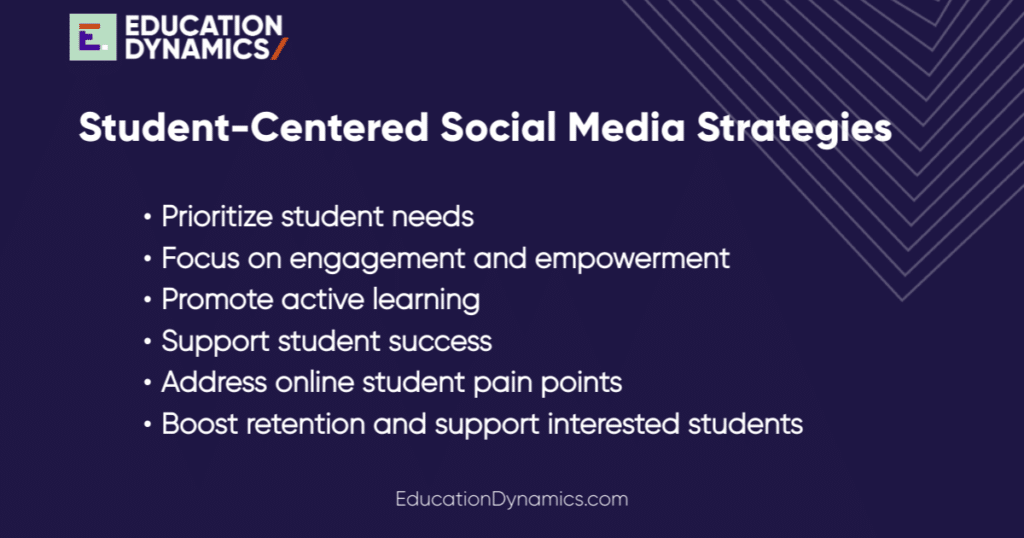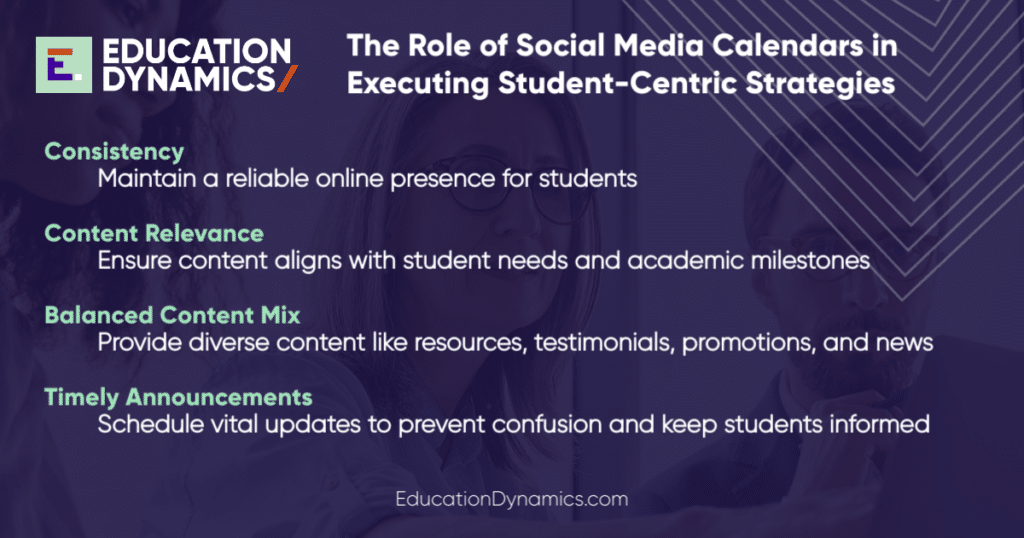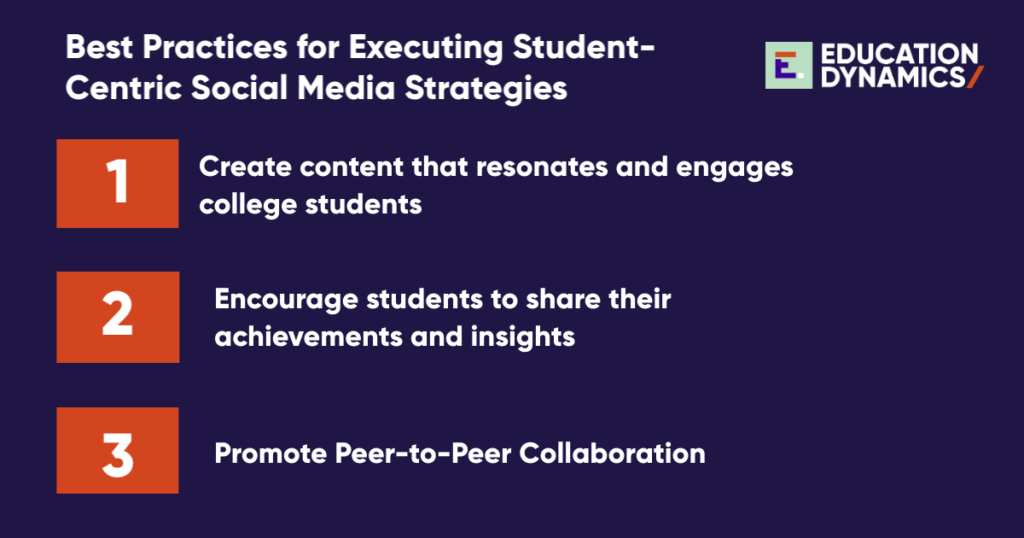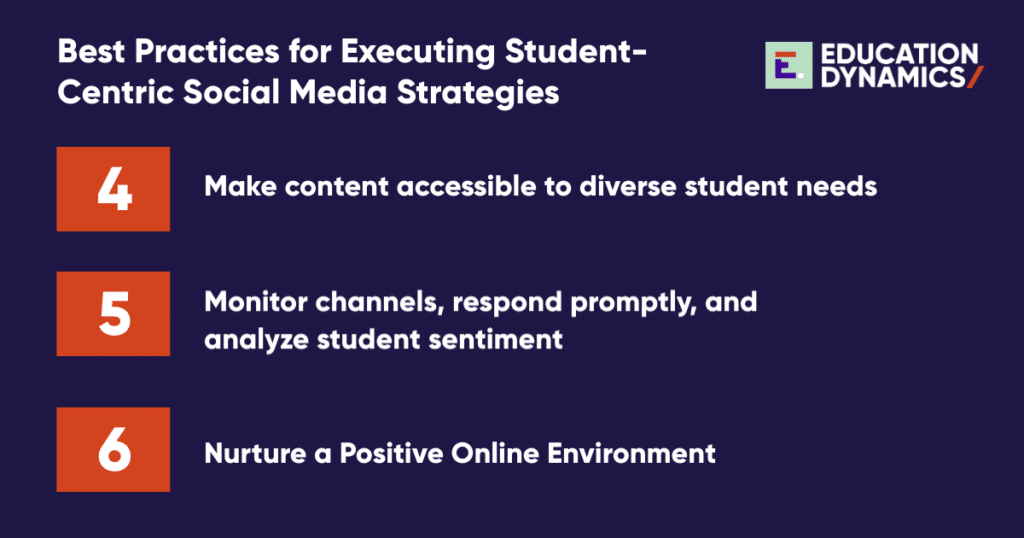Identifying and Addressing Student Pain Points with Student-Centered Social Media Strategies

Leveraging Social Media for Prospective Student Engagement
While humorous and entertaining content is often the content that performs the best across social media platforms (your mascot dancing to the latest audio trend), your social media team is also the first point of contact for many students and can help you address their needs. Students are already actively seeking solutions to their challenges on social media. In the last 30 days, people have used the hashtag #learnonTikTok over 712B times. Who says informative content can’t also be entertaining?
Students persist in their educational journey when they feel connected to the institution, their faculty, and their peers. Gen Z and millennials are looking for community, whether they attend college on campus or online, and social media can help you connect with both current and prospective students.
Lack of support can lead students to express complaints online and offline regarding these challenges or pain points. Your institution’s social media calendar should regularly address the challenges students encounter to increase retention among current students and demonstrate support for students interested in enrolling.
Identifying Common Pain Points of College Students

The landscape of higher education has changed drastically over the last several decades. Students may take a combination of online and in-person classes, and varying course lengths and start dates can cause confusion. Additionally, while online education has brought numerous benefits to college students, it has its challenges. Understanding student pain points is crucial as you aim to connect with and support learners. By leveraging the college social media calendar and reaching students where they are, you can effectively address these challenges and enhance the student experience.
Actively analyze interactions with learners to gauge their specific pain points and tailor your support accordingly. By monitoring direct messages, comments, and engagements with your social media posts, you can gain valuable insights into the challenges faced by current and prospective students.
By recognizing these pain points and strategically aligning your social media efforts, you can better support and empower college students in their educational pursuits.
Understanding Student-Centered Social Media Strategies
Definition of Student-Centered Social Media Strategies
Student-centered social media strategies are approaches to leveraging social media platforms that prioritize the needs of students with a focus on engaging and empowering students. The goal is to engage students, promote active learning, and support student success. In this case, it’s a great tool to regularly address the online student’s pain points to keep students retained and support interested students.

The Role of Social Media Calendars in Executing Student-Centric Strategies
Social media calendars are crucial in executing student-centered social media strategies in educational institutions. These strategies aim to engage and communicate effectively with students by tailoring content to their needs, preferences, and interests.
Here’s how social media calendars contribute to this:
- Consistency: Social media calendars help maintain a consistent social media presence that students can rely on to stay engaged and informed.
- Content Relevance: A student-centered strategy requires content that resonates with your student audience. Planning ahead lets you align your posts with important events, holidays, and academic milestones, ensuring your messaging is timely and relevant.
- Balanced Content Mix: A well-structured calendar ensures a balanced mix of content types, such as educational resources, student testimonials, event promotions, and campus news. This variety keeps students engaged and prevents content from becoming repetitive.
- Timely Announcements: Important announcements, such as registration deadlines, exam schedules, and campus closures, can be scheduled in advance. These announcements ensure that students receive crucial information on time and reduce the likelihood of confusion.

Key Elements of Effective student-centered Social Media Strategies
Social media can be a powerful tool for student engagement and learning in college settings. The specific strategies that you use will depend on the needs of your students and your institution.
The elements of an effective student-centered social media strategy include:
- Goals: What do you want to achieve with your social media strategy?
- Audience: Who are you trying to reach with your social media strategy? What are their interests, needs, and pain points?
- Content: What kind of content will you share on social media? Use what you know about your students to create relevant, timely, and engaging messages.
- Platforms: Which social media platforms will you use? Choose the platforms prospective and current students will most likely use.
- Schedule: How often will you post on social media? Make a plan for when and how often you post. And keep up with school events and deadlines in your posts.
- Engagement: How will you engage with both online and on-campus students on social media? This could include responding to comments and questions, running contests and giveaways, or hosting live Q&As.
- Measurement: How will you measure the success of your social media strategy? Measurements include tracking website traffic, social media engagement, and lead generation.
Best Practices for Student-Centric Social Media Strategies
Here are some considerations for implementing student-centered social media strategies to effectively engage students and enhance their overall experience. By adhering to these best practices, higher ed institutions can create a social media presence that supports students academically and cultivates a strong sense of community and belonging among online learners.


- Create Engaging Content: The foundation of any successful social media strategy is creating content that resonates with college students. Content should be not only informative but also visually appealing and engaging.
- Incorporate Student-Generated Content: Encouraging students to contribute their content can be a powerful way to create a sense of ownership and pride in their learning experiences.
- Encourage Peer-to-Peer Collaboration: College students often miss out on the in-person interactions that traditional students experience. To combat this, institutions can facilitate opportunities for peer-to-peer collaboration on social media platforms. Discussion forums, group projects, and virtual study sessions can all be organized through social media, fostering a sense of camaraderie among students.
- Ensure Accessibility and Inclusivity: Accessibility is critical when designing content for online learners. Institutions must ensure that all content is accessible to students with diverse needs. Accessibility includes providing alt-text for images, closed video captions, and using inclusive language in written content.
- Provide Timely Feedback and Support (Analyze Student Sentiment): Regularly monitoring social media channels and analyzing student sentiment is vital. Timely responses to questions, concerns, and feedback demonstrate that the institution is attentive to students’ needs. Institutions can identify potential issues early by assessing student sentiment and working to improve the online learning experience.
- Foster a Positive Online Learning Environment: An essential aspect of student-centered social media strategies is creating a safe and respectful online learning environment. Institutions should have strict policies against bullying or inappropriate behavior on social media platforms. A positive atmosphere ensures students feel comfortable expressing themselves and engaging with their peers.
Measure the Success of Student-Centric Social Media Strategies
Establishing Key Performance Indicators (KPIs) for Social Media Success
Tracking the effectiveness of these targeted communications helps higher education institutions understand the impact on student retention. By monitoring these metrics, institutions can identify trends and make data-driven decisions to improve student recruitment and encourage continued enrollment.
To effectively measure the success of student-focused social media strategies, it is crucial to establish key performance indicators (KPIs). These KPIs serve as benchmarks for tracking progress and determining the effectiveness of social media initiatives.
Monitoring and Analyzing Metrics to Measure the Effectiveness of Changes
After establishing KPIs, it is essential to continuously monitor and analyze relevant metrics to assess the effectiveness of any changes made to social media strategies. By regularly tracking metrics such as click-through rates, website traffic, conversion rates, and student enrollment/retention rates, institutions can gain insights into the impact of their strategies on student engagement and desired outcomes.
Collecting Feedback from Students and Adapting Strategies Accordingly
In addition to monitoring metrics, collecting feedback directly from students is another valuable way to measure the success of student-focused social media strategies. Social media platforms provide an interactive space where students can voice their opinions, express concerns, and converse with the institution. Institutions can gain insights into their needs, preferences, and expectations by actively listening to student feedback.
By implementing these approaches and consistently measuring the success of student-focused social media strategies, higher education institutions can optimize their efforts to engage students, improve retention rates, and provide a positive online learning experience.
Transforming Social Media Engagement with a Student-Centric Approach
Humorous and entertaining content typically sparks engagement, but it’s equally essential to recognize that your social media team is the initial touchpoint for many students seeking support. Addressing students’ pain points is vital to enhancing their experience and retention rates.
Social media calendars are vital for executing student-centered social media strategies for higher educational institutions. They provide a structured approach to content planning and delivery, ensuring that the institution effectively engages with its student audience and addresses their challenges.
By adopting these approaches, colleges and universities can establish stronger connections with their student body, increase engagement, and cultivate a positive online presence.
To transform your school’s social media engagement, connect with EducationDynamics’ team of social media strategists today and embrace a student-centric approach!